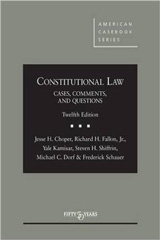In 2023, Tennessee enacted SB1, a law that, by its terms, has as one of its intended goals, “encouraging minors to appreciate their sex.” Lest there be any doubt, the operative provisions of SB1 make clear that by “their sex,” the Tennessee legislature meant their sex assigned at birth. SB1 is one of dozens of laws enacted in more than half the states in recent years forbidding minors from receiving gender-affirming care, even if they, their parents, and a licensed physician consent to such care.
Accordingly, transgender minors, their parents, and a doctor sued to enjoin the application of SB1. A federal district court judge agreed with them that SB1 is unconstitutional, but a 2-1 panel of the U.S. Court of Appeals for the Sixth Circuit reversed. Last week, an ideologically divided Supreme Court affirmed. Writing for the conservative super-majority in United States v. Skrmetti, Chief Justice John Roberts rejected the plaintiffs’ contention that SB1 discriminates on the basis of sex or transgender status.
The Chief Justice’s opinion is not exactly offensive on its face. It uses terms like “transgender boy” in a matter-of-fact manner. Thus, it does not simply seek to erase or deny the existence of transgender persons. In that respect, it is better than the rhetoric emanating from the Oval Office. For example, in February of this year, President Donald Trump issued an Executive Order titled “Keeping Men Out of Women’s Sports.” Whatever one thinks about participation of transgender female athletes in competitive sports, there is no reason other than spite for the government to go out of its way to disparage their identity and deny their very existence.
That said, avoiding the rhetorical gutter that is characteristic of our current president is far too low a bar to set for the Supreme Court. And while the tone of the majority opinion in Skrmetti may be civil, its substance is highly problematic. Indeed, by treating the Tennessee legislature as having carefully attended to the medical evidence regarding the benefits and risks of puberty blockers and hormone therapy, the Court sanitizes the wave of transphobia washing over the United States.
The Holding: Not Sex Discrimination or Transgender Status Discrimination
Laws banning gender-affirming care for minors might be thought to violate the Constitution in a number of ways. By effectively compelling trans youth to live in a body that is incongruent with their identity, such laws could be deemed a violation of the fundamental right to bodily integrity. To be sure, the current Supreme Court is very unlikely to find such a violation. In its 2022 decision overruling the abortion right, the Court adopted a history-and-tradition test for fundamental rights. It seems that the very purpose of this approach is to rule out “new” rights, especially those that challenge traditional morality.
Before the Supreme Court, the Skrmetti case presented only a single issue: whether SB1 violates the Fourteenth Amendment’s Equal Protection Clause. The plaintiffs argued that SB1 should be judged by the intermediate scrutiny standard applicable to laws that discriminate on the basis of sex. Their argument was straightforward: the same drugs that Tennessee bans for the purpose of gender-affirming care for transitioning minors are allowed for a variety of purposes (such as treatment of precocious puberty) in non-trans minors. Thus, as Justice Sonia Sotomayor explained for herself and the two other Democratic appointees in dissent: “Male (but not female) adolescents can receive medicines that help them look like boys, and female (but not male) adolescents can receive medicines that help them look like girls.”
Nonetheless, the majority opinion denied that SB1 draws sex-based lines. Chief Justice Roberts wrote for the majority: “Notably absent from” the “framing” of the issue by the plaintiffs and dissenters “is a key aspect of any medical treatment: the underlying medical concern the treatment is intended to address.” He said that
for the term “medical treatment” to make sense, [it] must necessarily encompass both a given drug and the specific indication for which it is being administered. [When], for example, a transgender boy (whose biological sex is female) takes puberty blockers to treat his gender incongruence, he receives a different medical treatment than a boy whose biological sex is male who takes puberty blockers to treat his precocious puberty. . . . Under SB1, no minor may be administered puberty blockers or hormones to treat gender dysphoria, gender identity disorder, or gender incongruence; minors of any sex may be administered puberty blockers or hormones for other purposes.
There is at most a highly formalistic logic to that reasoning. As Justice Sotomayor responded in dissent:
The problem with the majority’s argument is that the very “medical purpose” SB1 prohibits is defined by reference to the patient’s sex. Key to whether a minor may receive puberty blockers or hormones is whether the treatment facilitates the “medical purpose” of helping the minor live or appear “inconsistent with” the minor’s sex. That is why changing a patient’s sex yields different outcomes under the Tennessee law.
Indeed, even Justice Samuel Alito, who agreed with the majority that SB1 should be upheld, thought it difficult to deny that the law discriminates on the basis of transgender status. (He nonetheless voted to uphold the law because he also thought that transgender status is not a suspect or semi-suspect classification that triggers heightened judicial scrutiny.)
Level of Scrutiny
Because the Skrmetti majority rejected the plaintiffs’ contention that SB1 discriminates based on sex, it did not apply the intermediate scrutiny applicable to laws that do so discriminate. And because it rejected the contention that the law discriminates based on transgender status, the majority found it unnecessary to decide whether laws that do discriminate based on transgender status trigger heightened scrutiny. For the same reason, the Court did not decide whether the logic of its 2020 ruling in Bostock v. Clayton County—which held that discrimination based on sexual orientation and transgender status are proscribed forms of sex discrimination under Title VII of the 1964 Civil Rights Act—applies to claims under the Equal Protection Clause.
Three Justices wrote separately to reject the Bostock logic, each opining that transgender status discrimination should not trigger any equal protection heightened scrutiny. Justice Amy Coney Barrett’s reasoning in support of these conclusions was especially odd. Justice Barrett began by recounting the factors that have figured in prior decisions to treat some personal trait as suspect and thus a trigger for heightened scrutiny. But she then applied these factors in ways that seem perverse.
Quoting lower court opinions that described a criterion for suspect classification status as a trait that is “definitively ascertainable at the moment of birth,” Justice Barrett noted that the plaintiffs “began to experience gender dysphoria at varying ages—some from a young age, others not until the onset of puberty.” But it is hardly clear why a characteristic that marks people for discrimination needs to be ascertainable at birth. And even if that is true of some suspect classifications (such as race, which is typically visible at birth), it makes little sense to disqualify transgender status on this ground when that very status is defined by incongruence with sex assigned at birth.
Justice Barrett also noted that traits indicative of suspect classifications are typically immutable, that is, unchanging. This criterion also seems backwards when applied to persons whose identity is defined by a desire to change their physical bodies to better match their interior sense of self.
Justice Barrett added that transgender status is not immutable because “some transgender individuals ‘detransition’ later in life.” However, she did not in any way quantify this phenomenon, and the best estimates indicate that detransitioners are a relatively small minority—approximately 13 percent according to a 2021 study. (That study also found that more than four out of five detransitioners cited external pressure from family members and others as playing a causal role in their decision to detransition.)
Moreover, why should the fact that some people detransition matter for those who do not? Surely Justice Barrett was not suggesting that the existence of detransitioners means that non-detransitioning transgender individuals have simply made a choice to be transgender. If not, then transgender status is immutable for the vast majority of transgender people.
Meanwhile, Justice Barrett’s rigid version of immutability is difficult to justify. Suppose that 13 percent of all people underwent spontaneous physical changes at some point in adulthood so that their perceived race (a social construct rather than a scientific fact in the first place) changed. Suppose further that our country’s history had still included racialized slavery, segregation, and persistent race discrimination. In such circumstances, it would make little sense to conclude that race is not a suspect classification simply because it is mutable for some.
Finally, and perhaps most perversely, Justice Barrett opined that the plaintiffs had pointed only to a history of private discrimination against transgender individuals but that heightened scrutiny is keyed to evidence of discrimination by government. Yet Justice Barrett and the Court could and should have taken judicial notice of the fact that transgender individuals have indeed been the victims of historical—and intensifying—official discrimination.
Although some of the terminology used by and about transgender persons is relatively new, the phenomenon has existed for centuries. So too has been the pattern of private stigma and legal condemnation. In the middle of the nineteenth century, many jurisdictions in the United States enacted laws specifically forbidding the wearing of clothing typically worn by persons of the opposite sex. And long before the adoption of those laws, such behavior was punished in colonial America and the early Republic under various legal rubrics. The current wave of anti-trans laws—including SB1 and similar laws in other states, laws regarding restroom use, restrictions on transgender female athletes, and executive actions like the purge of trans service members from the military—is new in the sense that it reflects a backlash against the assertion and partial recognition of some trans rights, but it embodies the same anti-trans prejudices that have long infected American law.
Applying Intermediate Scrutiny
If Skrmetti has a silver lining, it is that only three Justices expressly rejected intermediate scrutiny for anti-trans laws. It thus remains open to plaintiffs in future cases to argue that where no one can deny that a law expressly discriminates based on transgender status, it should be subject to such scrutiny. Further, as noted above, Skrmetti does not even rule out other constitutional grounds for challenging laws banning gender-affirming care for minors—perhaps before a future, more progressive, Court.
In the meantime, Skrmetti reflects a missed opportunity. As Professor Jeannie Suk Gerson recently observed in The New Yorker, the Biden administration may have inadvertently undercut the plaintiffs’ case by overstating the medical consensus regarding gender-affirming care for minors. There is legitimate uncertainty about the safety and advisability of various treatment modalities for transgender youth. The majority opinion and a concurrence by Justice Clarence Thomas pointed to changed guidance in Sweden, Norway, France, the Netherlands, and the United Kingdom to suggest that current medical practice in the United States might be misguided in too freely prescribing puberty blockers and hormone therapy. For that reason, the majority concluded, Tennessee’s SB1 is rational.
Yet the Court could have reached nearly the same conclusion applying intermediate scrutiny or its equivalent. The Court could have acknowledged the obvious—that laws like SB1 are packaged by their proponents as reflecting concerns about informed consent and the best medical interests of young patients, even as they also reflect animus against the very existence of transgender individuals. What else could SB1 possibly mean when it admits—indeed advertises—that minors should appreciate the sex they were assigned at birth?
The Court could and should have said that states have a substantial interest in ensuring that minors are actually giving informed consent and in preventing the over-prescription of puberty blockers and hormone therapy but that Tennessee’s blanket ban goes too far. By failing to take that step—by dignifying SB1 as the product of an unbiased legislature simply looking out for the health and welfare of its young citizens—the Court has fit a velvet glove on the iron fist of the ongoing campaign to demonize transgender persons.











